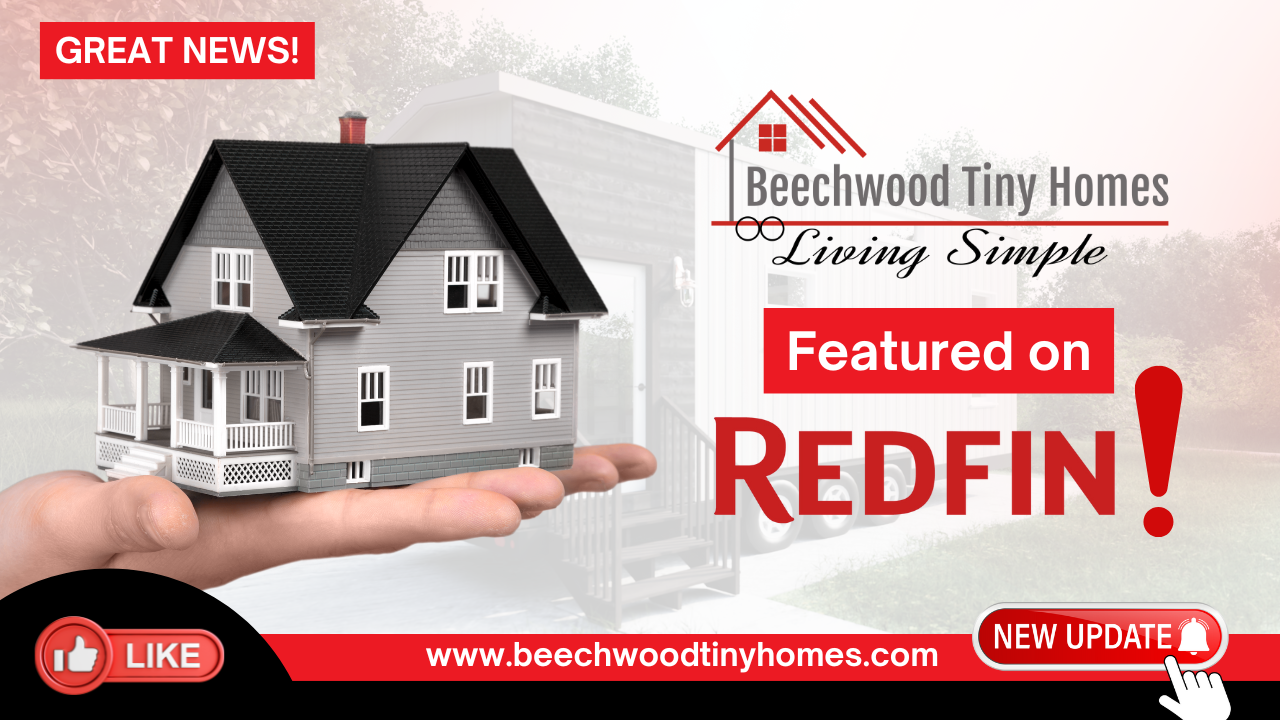
The Joy of New Beginnings: Financing and Moving Into Your Tiny Home!
Picture this: you’re standing in front of your newly financed tiny home, keys in hand, about to step into a simpler, more intentional way of living. This isn’t just a real estate transaction—it’s a lifestyle shift, a reflection of your values, and the beginning of a more sustainable future.
Financing and taking possession of your tiny home is a big milestone. It’s more than opening the door to a compact space—it’s opening up to freedom, flexibility, and the joy of living with less. Whether you’re excited to personalize your home or reduce your carbon footprint, this move is a meaningful one.
Choosing the right financing option is a big part of the journey. It’s not just about the loan—it’s about finding a path that aligns with your goals. And when you do, you’re not just buying a home. You’re making a bold, intentional choice to live life on your terms.
Exploring Tiny Home Financing Options

Tiny homes are more than a trend—they’re a solution for people seeking simplicity, affordability, and environmental responsibility. But how do you finance one? Let’s break it down.
In our fast-paced world, tiny homes have captured many people’s imaginations, offering simplicity and eco-conscious living. These small, efficient spaces speak to those longing for minimalism or a greener lifestyle. But how do you turn this dream into reality? It starts with understanding your financing options, from personal loans to tiny home-specific mortgages, each serving unique needs and financial aspirations.
Diving into these financing routes, you’ll discover strategies that resonate with your values. As you set off on this journey, it’s vital to consider all financial avenues, making your tiny home dream a reality. Ready to begin this exciting adventure? Let’s delve into the best financing options to transform your tiny home dreams into reality. For more comprehensive guidance, visit bankrate.com.
Mortgage & Personal Loan Options for Tiny Home Financing

1. Tiny Home Mortgages
Some banks now offer mortgages specifically for tiny homes, especially if your home is part of a land-home package. Institutions like 21st Mortgage provide financing that considers the unique nature of tiny living—including whether your home is mobile or fixed.
Keep in mind:
- Your tiny home may need to be placed on a permanent foundation.
- The land, construction, and location all affect eligibility.
- Use resources like Triad Financial Services to understand your mortgage options.
2. Personal Loans
If your tiny home doesn’t qualify for a mortgage, a personal loan might be the way to go.
- No collateral required—great for movable homes.
- Fast approvals—sometimes within days.
- Higher interest rates—so evaluate carefully.
Lenders like LightStream offer flexible terms that may work for your situation.
Government Programs and Non-Profits That Support Tiny Home Financing

Exploring all financing avenues includes considering government assistance and non-profit programs designed to support tiny home buyers. These initiatives can provide valuable assistance through grants, low-interest loans, or other incentives that align with sustainable and affordable living goals.
3.Government Programs
Several government programs may support tiny home financing, particularly those targeting sustainable living or affordable housing. Programs such as the U.S. Department of Agriculture’s Rural Development loans or HUD’s various affordable housing initiatives could offer terms that favor tiny home buyers.
-
USDA Loans: Specifically, these can be applied in rural areas to promote sustainable living, often with favorable terms.
-
HUD Programs: Additionally, HUD offers programs aimed at affordable housing, which can sometimes apply to tiny home projects.
To explore these options, contacting local housing authorities or checking government websites can provide updated guidance and availability.
4. Non-Profit Organizations
Numerous non-profits focus on housing affordability and sustainable living, providing resources ranging from financial assistance to community support networks.
-
Habitat for Humanity: Known for building homes, they sometimes incorporate tiny homes into their projects or provide financial guidance tailored to low-income families.
-
The Bungalow Association: Additionally, organizations like this focus on promoting tiny homes as affordable housing solutions, offering counseling and resources to potential buyers.
By reaching out to these non-profits, you can access unique assistance opportunities, enhancing your financial strategies for securing a tiny home.
Incorporating these alternative paths into your financing strategy can provide additional support in your journey toward owning a tiny home, thereby ensuring a comprehensive approach to meeting your housing aspirations.
5. Retail Project Financing to Fund Your Tiny Home
In addition to traditional loans and mortgages, box stores like Home Depot offer unique project financing options that can be invaluable when embarking on home improvement projects, particularly those meant to enhance your new tiny home. Whether you’re looking to install new solar panels, upgrade your kitchen, or make sustainable modifications, these financing programs can significantly help make those projects more affordable and manageable.
Home Depot Project Loan
Home Depot provides a Project Loan program that allows for larger purchases with the flexibility of a credit card. Here’s how it works:
-
Credit Limit: You can borrow up to $55,000 for your projects.
-
Fixed Rate: It offers a fixed APR, giving you predictable payments.
-
Flexible Terms: You can choose repayment terms up to 84 months, thus providing ample time to complete and pay for your projects.
-
No Annual Fee: Unlike some credit cards, there’s no annual fee, which therefore makes it a cost-effective choice for financing.
For more information and to apply for a Home Depot Project Loan, visit Home Depot’s Financing Page.
By utilizing such financing options, you can undertake essential renovations or customizations without the burden of immediate full payment, consequently making your transition into tiny home living smoother and more financially viable. These project loans offer both convenience and financial flexibility, thereby aiding in the realization of your dream home’s upgrades.
How Credit Scores & DTI Ratios Affect Tiny Home Financing

When considering financing for your tiny home, understanding the importance of credit scores and debt-to-income (DTI) ratios is crucial. These factors significantly influence your borrowing capabilities and the terms of your loan.
Credit Scores: A Reflection of Financial Health
A credit score is a numerical representation of your creditworthiness, indicating to lenders how likely you are to repay borrowed money. Generally, scores range from 300 to 850, with a higher score suggesting better creditworthiness. Here’s how it plays into your tiny home financing:
-
Interest Rates: For starters, higher credit scores often lead to lower interest rates, thereby making your loans more affordable in the long run.
-
Loan Approval: Additionally, while lenders have different thresholds, a good credit score generally improves your chances of loan approval.
-
Loan Amounts: Moreover, a strong credit score may allow you to borrow larger amounts, offering greater flexibility in your tiny home project.
Thus, to maintain or improve your credit score, ensure timely payment of bills, reduce outstanding debt, and avoid new credit inquiries unless necessary.
Debt-to-Income Ratios: Balancing Income and Obligations
The debt-to-income ratio is the percentage of your monthly gross income that goes toward paying debts. Moreover, it’s a vital metric for lenders in assessing your ability to manage monthly payments and repay borrowed funds. Here’s why it’s essential:
-
Lending Decisions: Consequently, a lower DTI ratio is preferable, indicating that you have a healthy balance between debt and income, potentially increasing your likelihood of securing financing.
-
Financial Readiness: Furthermore, understanding your DTI can help you assess whether you’re financially ready to take on additional debt, ensuring your tiny home does not become a financial burden.
To calculate your DTI ratio, divide your total monthly debt payments by your monthly gross income. Typically, a DTI ratio below 36% is considered favorable by most lenders.
In summary, grasping the impact of credit scores and DTI ratios can empower you to make informed decisions about financing your tiny home. By maintaining a strong credit score and a healthy DTI ratio, you are thereby better positioned to secure favorable loan terms, ultimately facilitating a smoother transition into your new lifestyle.
Why NOAH Certification Helps With Tiny Home Financing & Insurance
Getting your tiny home certified by NOAH (National Organization of Alternative Housing) can open doors—literally.
- Easier Financing: Lenders are more comfortable with certified builds.
- Smoother Placement: Helps with zoning and legal requirements.
- Better Insurance: Insurers are more likely to provide coverage for certified homes.
It’s a small step that can make a big difference in the long run.
Final Thoughts: This Is More Than Just a House
Financing your tiny home is about more than money—it’s about making a lifestyle choice. Whether you’re going off-grid, downsizing, or seeking financial freedom, your tiny home is a reflection of who you are and what matters most.
Take your time exploring your financing options. Talk to experts. Ask questions. Then step into your tiny home with confidence—knowing that every detail, from the foundation to the financing, supports the life you’re building.
GREAT NEWS!
Beechwood Tiny Homes we’re Features on Redfin!

We’re excited to share that we’ve been featured in a recent Redfin article!
Victorian windows are making a major comeback — blending vintage charm with modern aesthetics. Whether you’re in Boston, MA, showcasing ornate windows with sleek interiors, or in New Orleans, LA, pairing intricate designs with bold elements, this article offers beautiful design inspiration.
Check out the full article here:
Victorian Windows in Modern Homes: How to Get the Look | Redfin
This feature highlights how timeless design elements like Victorian windows can add elegance and character to any home. We’re proud to be part of this conversation!
Ready to Start Building Under New Hampshire Tiny Home Regulations?
There’s never been a better time to build your tiny home in New Hampshire.
With new regulations, more space, and an experienced team on your side, your dream is closer than ever.
📞 Call Us Today: (833) 333-8469
📧 Email Us: sales@beechwoodtinyhomes.com
🌐 See what’s available: 8×28 Tiny Home for Sale
Whether you’re building a primary residence, a guest suite, or a vacation property, Beechwood is ready to help you thrive under New Hampshire tiny home regulations.
